#this chapter we have heavy survivors guilt discussion of war the point in living a major mental and physical breakdown
Link
Chapters: 5/?
Fandom: Star Wars: The Clone Wars (2008) - All Media Types, Star Wars - All Media Types
Rating: Teen And Up Audiences
Warnings: Graphic Depictions Of Violence
Relationships: Clone Commander Blackout & CT-7567 | Rex, ARC-77 | Fordo & CT-7567 | Rex, Coric & CT-7567 | Rex
Characters: Clone Commander Blackout (Star Wars), CT-7567 | Rex, ARC-77 | Fordo, Clone Trooper Coric (Star Wars), ARC Trooper Stec (Star Wars), Anakin Skywalker, Ahsoka Tano, Original Clone Character(s)
Additional Tags: Planet Teth (Star Wars), Post-Battle Of Teth, Post-Battle of Christophsis, Teth is its own warning, Battle of Hypori, there's a lot going on ok, Alternate Universe, Jai'galaar Verda AU, Other Additional Tags to Be Added, No Beta we die like. like. everyone from torrent-, Author Is Sleep Deprived, The Author is Screaming, Stec Is a Good Bro
Series: Part 3 of Jai'galaar Verda
Summary:
Blackout received his Jaig eyes recently - only to learn that, apparently, he now is part of ancient magic.
Fordo and his squad have been called in to save Jedi, but there is more than just one thing off about... well, everything, unfortunately. It just can't ever be easy, can it?
Rex has a lot to do, between the shriek-hawk in his head and the new padawan in his legion. Soon, both will be the least of his problems.
[You have to read at least Blue before this one - it's a direct continuation.]
#captain rex#captain fordo#commander blackout#oh damn i just realized the baby of this trio does not only have the braincell but outranks the others lmao#jai'galaar verda au#arc strooper stec#stec#the teth six are the teth seven now because rex is one of them dammit#ahsoka tano#my writing#this chapter we have heavy survivors guilt discussion of war the point in living a major mental and physical breakdown#and a conversation i think is hilarious
1 note
·
View note
Text
15 things about Ishval that Brotherhood cut out

After rewatching Fullmetal Alchemist Brotherhood recently, I was once again extremely disappointed at the amount of content the anime cut out when it covered the Ishval war in episode 30. Volume 15 of the manga (which was entirely dedicated to showing the war in detail across four chapters) still remains my favourite volume of the whole series, so I wanted to talk about 15 things that Brotherhood cut out. Some of them are minor scenes and some are more major plot points.
The images I’ve included in this post have been taken directly from the Viz Media manga, as I really dislike the poor quality scanlations of FMA that are out there. I would highly recommend buying Volume 15 for yourself, even if it’s the only volume of FMA you ever own.
The things I’ll be covering are:
Neighbouring country Aerugo’s role in the war
The Ishvalans as people - their lives and strengths
The Rockbells’ extra scenes
The military’s order to kill the Rockbells
Roy, Hughes, and Hawkeye’s extra scenes
Hughes’ extended scenes as a squad captain
Corruption of high-ranking officers and internal assassination
Armstrong’s extra scene
Torture & human experimentation of Ishvalans
Doctor Marcoh & Doctor Knox’s extra scene
Roy’s role as the Hero of Ishval
Scar’s brother’s scenes
Roy’s squad
Children as the victims of the war
The overall portrayal of the war, and how Volume 15 was written/illustrated
** VERY LONG POST UNDER THE CUT, VERY IMAGE HEAVY **
Let’s begin!
1. Neighbouring country Aerugo’s role in the war
Aerugo is the country to the south of Amestris. It’s mentioned in the series that both countries are constantly fighting a war on the border. During the Ishvalan war, the Amestrian military discovers that Aerugo is supplying weapons to Ishval in order to aid them in defeating Amestris. (ch.58)
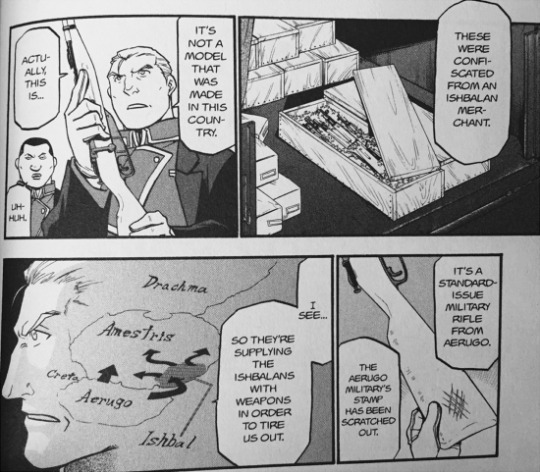
This discovery is then used as an excuse to purge all Ishvalans from within the military, by claiming that interior soldiers were the ones supplying the weapons. (ch.58)
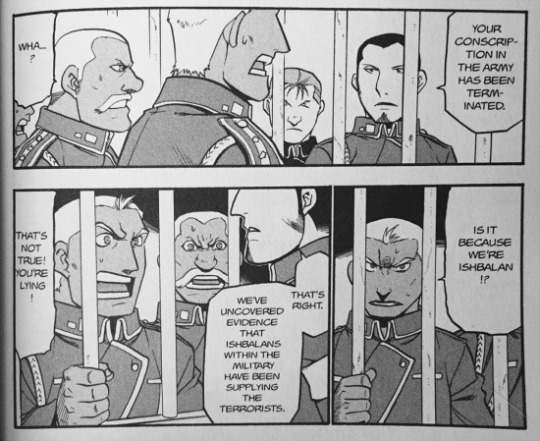
Later on, when the war has become a full-blown extermination, Ishvalan civilians are seen at the Aerugo border pleading with the border forces to let them in as refugees. Aerugo, despite previously aiding Ishval with weapons, refuses to let them in. (ch.60)
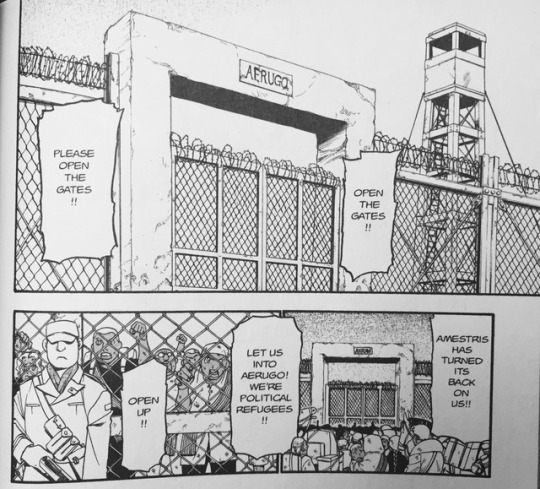
2. The Ishvalans as people - their lives and strengths
Throughout the beginning of Volume 15, we’re shown short glimpses of the everyday lives of ordinary Ishvalans. We see their markets and their homes; we’re shown children playing in the streets and adults talking to each other. This is later juxtaposed with the destroyed landscape of rubble, blood, and bodies (which I’ll talk about more later on). It really helps to reinforce the fact that Ishvalans were just innocent people with ordinary lives as opposed to only existing to be exterminated and further the plot, which is the impression I got from Brotherhood.
Also cut out from the anime is just how powerful the Ishvalans were. Take this panel from chapter 59:
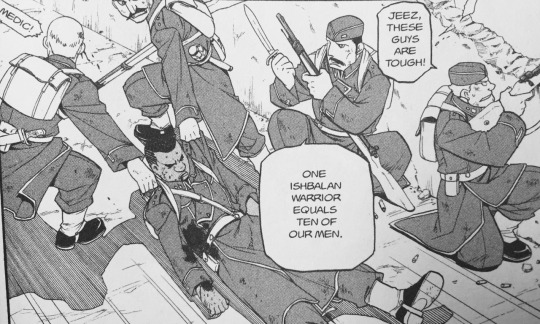
This is just one of a few examples in which Amestrian soldiers are discussing how strong the Ishvalans are. It’s stated that if not for the intervention of the State Alchemists, Ishval probably would have won the war by strength alone.
3. The Rockbells’ extra scenes
The amount of screentime given to Winry’s parents in Brotherhood is so disappointing. In the manga we got to see a lot more of them. It was shown that a lot of their Ishvalan patients were hostile towards them (ch.58)
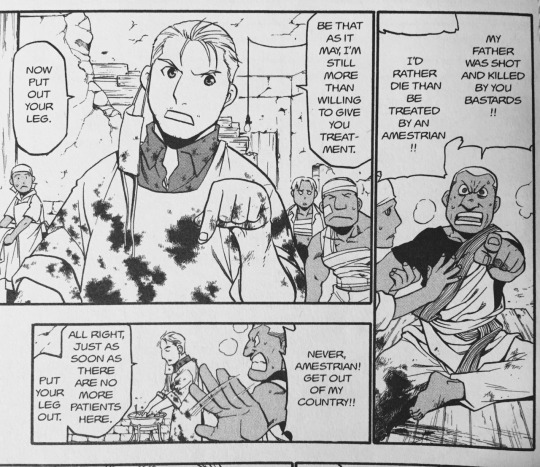
We see them struggling to treat patients as their medical supplies become scarce and slowly stop being provided to them. They were even warned about the extermination campaign and told to leave Ishval to avoid being killed (ch.58)
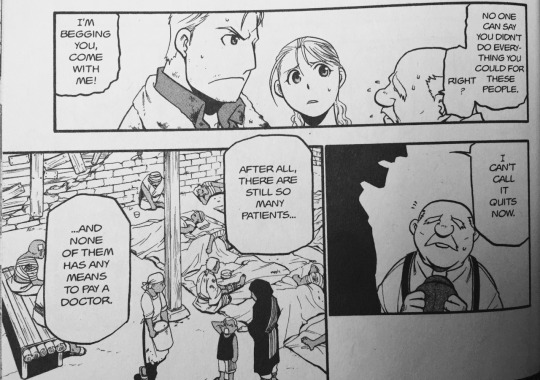
Of course, they both refuse to leave and instead stay to continue to treat patients. We see other Amestrians bring food and supplies for the Ishvalan patients, and some Ishvalan children even appear and offer to help the doctors treat people. Overall, the Rockbells are shown to be hard working and to have hope for the future despite their struggle. This hope is later tested towards the end of the volume as more and more people are brought in and medical supplies run out.
4. The military’s order to kill the Rockbells
I couldn’t believe that this was something which was cut from the anime. In the manga (chapter 60), a higher-up commands Kimblee to discreetly kill the Rockbells, as their treatment of Ishvalan patients is damaging Amestris’ efforts in the war.
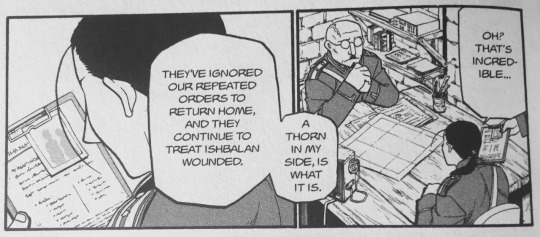

Kimblee is happy to take the job, but the Rockbells have already been killed by Scar when he arrives. Kimblee then remarks that he admired their conviction to continue treating patients to the end.
Much later during the Briggs arc, Kimblee mentions to Winry that he was part of the squad which recovered her parents’ bodies and mentions their family picture. In actual fact he had been sent to kill them. The assassination plan was never revealed to Ed, Al, or Winry.
5. Roy, Hughes, and Hawkeye’s extra scenes
I’ll only touch on this briefly, as Brotherhood did include most of the scenes where Roy and Hughes were discussing the war and their ideologies. However, a big scene which Brotherhood cut was one in which Roy and Hughes are unexpectedly attacked by an Ishvalan and are saved by Hawkeye’s sniper shot. (ch.59)
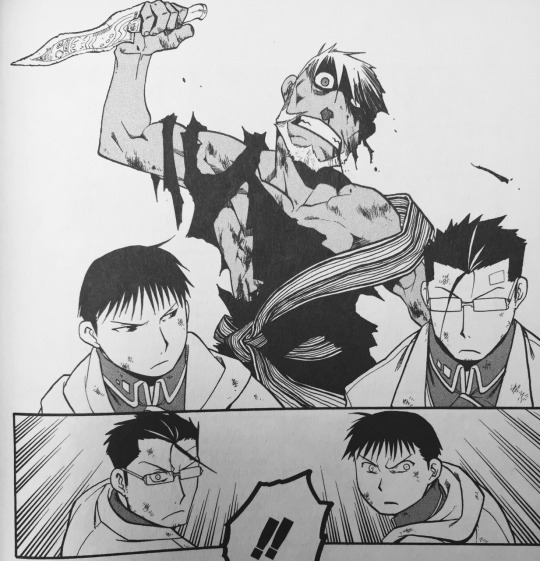
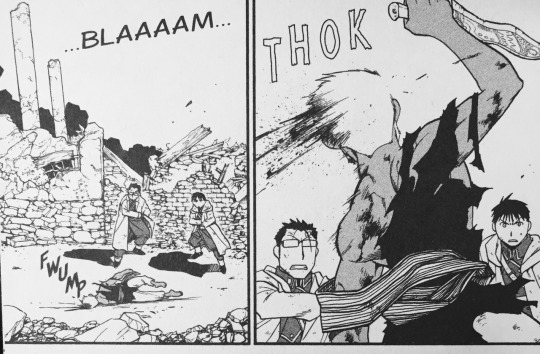
This is a much more interesting way to reunite Roy and Hawkeye IMO, since both we the audience and Roy see her actively taking part in the war.
6. Hughes’ extended scenes as a squad captain
This is probably the part which I most wanted to see included in Brotherhood. We see Hughes actually being a soldier, and being damn good at it. In chapter 60 he’s assigned to a sector under the command of Brigadier General Fessler, who I’ll discuss more in point 7. Hughes is ordered to lead a squad into a very dangerous battlefield and as a result sees many of his men die.
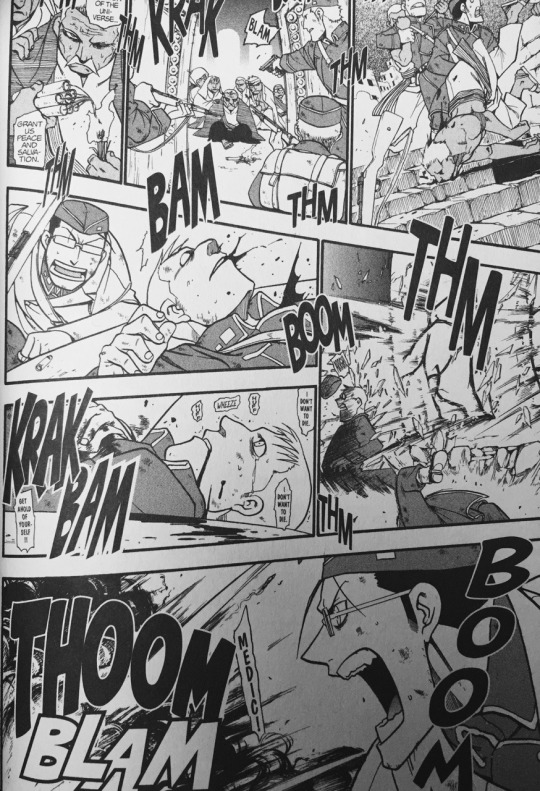
It’s at this point that Logue Lowe raises a white flag and requests to be taken to King Bradley to offer his life in exchange for an end to the war. Hughes is the one that Logue Lowe makes contact with, and their interaction is quite heartfelt. Both sides just want the war to be over.

Hughes agrees to take Lowe to Fessler, his commanding officer, which leads me to my next point...
7. Corruption of high-ranking officers and internal assassination
Before Hughes’ scene with Logue Lowe, we’re shown that Commander Fessler is a reckless, arrogant soldier. He sees war as a game and has no issue sending his soldiers out into dangerous situations. As a result, he gets a lot of Amestrian soldiers killed unnecessarily, and it’s clear that everyone under his command finds his attitude repulsive.
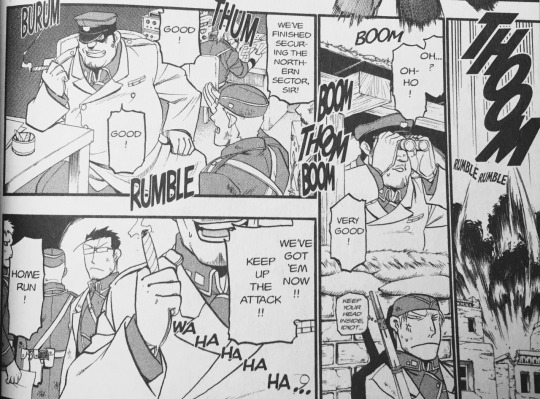
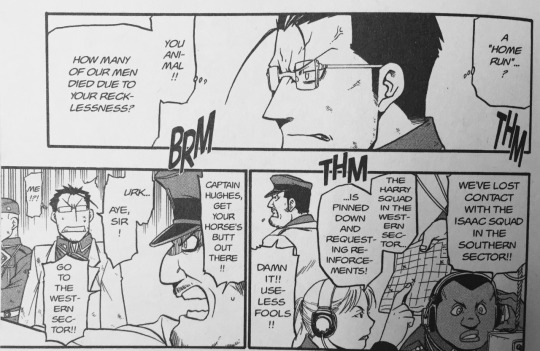
This all comes to a head when Hughes and Basque Grand escort Logue Lowe back to Fessler to request an audience with King Bradley. Fessler yells at them and orders them to take the Ishvalans out and shoot them all. Having had enough of his deplorable nature, Basque Grand takes matters into his own hands and assassinates Fessler on the spot.

None of the other soldiers are fazed by this. They unanimously decide to blame Fessler’s death on a “stray bullet”, and allow Basque Grand to take command.

8. Armstrong’s extra scene
In Brotherhood we’re shown Armstrong’s breakdown and subsequent removal from the battlefield. However in chapter 59 there’s an extra scene which adds more to Armstrong’s character and his emotions about the war.
After dozens of Ishvalans are shot dead against the wall he created with alchemy, Armstrong is overwhelmed with guilt and makes a hole in the wall to allow two survivors to escape.

The survivors seem grateful towards Armstrong, but after escaping they are immediately blown away by one of Kimblee’s explosions right in front of his eyes.

Kimblee then comments to Armstrong that if anyone else had seen him aiding Ishvalans, he would have been court martialed. Armstrong collapses to the ground, traumatised and defeated.
9. Torture & human experimentation of Ishvalans
It’s no secret that Ishvalans were experimented on in order to create philosopher’s stones. This is clearly touched upon in Brotherhood, although the manga arguably makes it more horrifying.
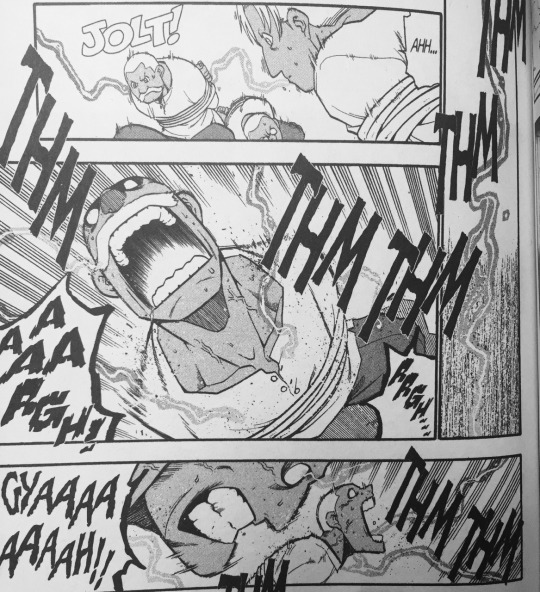
What Brotherhood didn’t include is the fact that Ishvalans were being subject to torture under the guise of experiments.
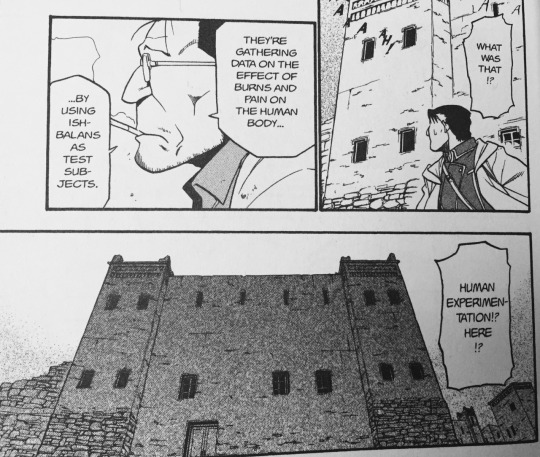
I’m very glad that the scene inside the building was not illustrated. It’s already chilling to see Doctor Marcoh reacting to the screams and Doctor Knox’s casual explanation. The fact that we’re not able to see what’s happening and have to use our imagination is enough to get the picture.
10. Doctor Marcoh & Doctor Knox’s extra scene
Speaking of Doctor Marcoh and Doctor Knox, the entire scene between them is very interesting. In Brotherhood we don’t see them interact much (if at all) until the end of the series. In the manga they are discussing their roles as doctors. They even mention the Rockbells and how they differ from each other as doctors.
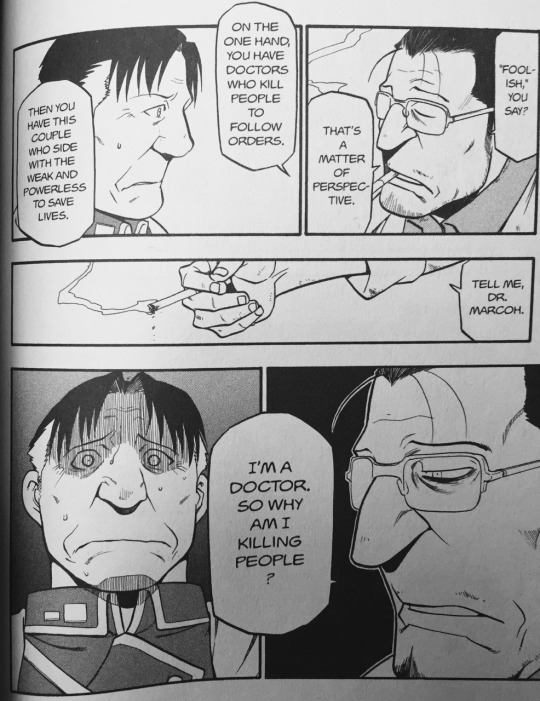
This panel is nicely mirrored by the following panel on the opposite page:
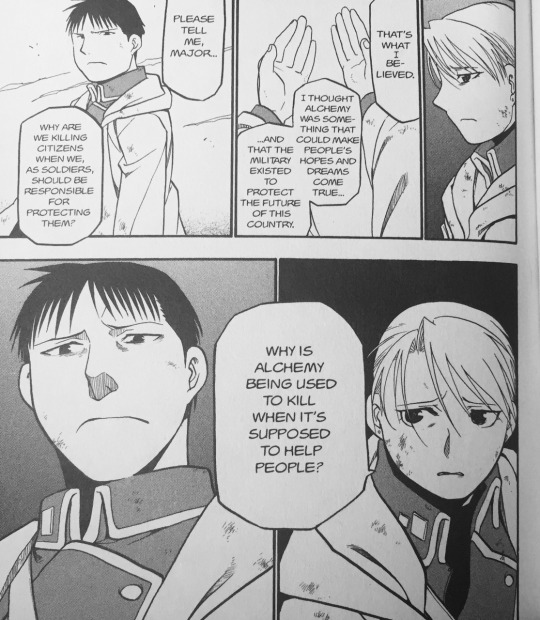
It’s hard-hitting to see characters we care about questioning the reasons for the war, and how their abilities are being used to kill rather than to help. It’s not a case of them acting like victims, but more voicing the fact that the world is wrong and something needs to change.
11. Roy’s role as the Hero of Ishval
This is yet another scene which I was surprised that Brotherhood cut out. In the first 14 volumes of the manga we see Roy being addressed as “The Hero of Ishval”, but the reason is never explained. In chapter 61 it’s revealed that he was the one who actually ended the war by killing the “last” Ishvalan, a defenseless old man with a dog.
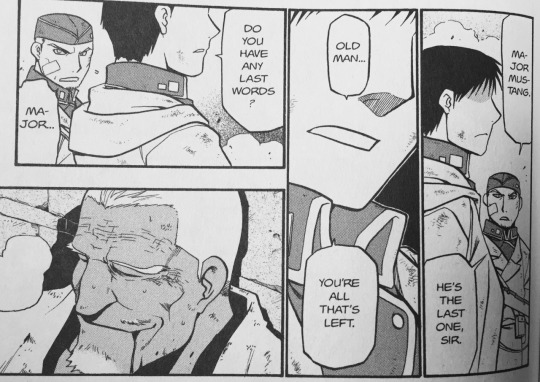
Roy’s face is masked in the beginning of the scene. He allows the man the chance to say his last words. The Ishvalan smiles and he chooses his words carefully, looking Roy right in the eyes as he says them:

Roy’s face here says it all. Those words will haunt him for the rest of his life. The war is over, but it doesn’t feel like a victory. Gaining the title of the “Hero of Ishval” does nothing for Roy but fill him with self-hatred (this is shown a few pages later).
12. Scar’s brother’s scenes
Another point which I’m only going to touch on briefly. I do think that Brotherhood covered all of Scar’s brother’s scenes, however I personally dislike the fact that Scar’s flashbacks were spread out over several episodes. It almost felt like Scar’s brother had less scenes in the anime because of this. It’s much easier to follow his story when it’s included within the war and isn’t split into rushed parts.
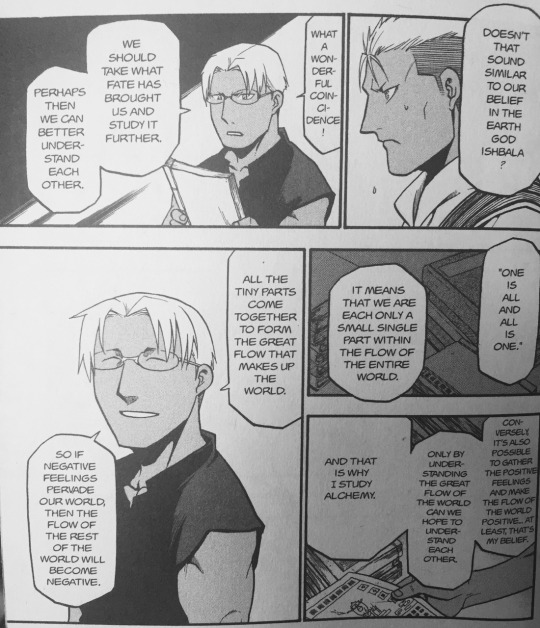
The manga also emphasises his optimism and his belief that Amestrians and Ishvalans have a lot in common and can live peacefully together. He truly believes that individuals can change the flow of the world to become positive.
13. Roy’s squad
During the Promised Day arc, Roy calls upon several men to help him in the coup d’etat. In Brotherhood it isn’t really explained who these men are, where Roy knows them from, or why he recruited them to help out. Well, in the manga we’re introduced to them much earlier on and we learn that they’re all surviving members of Roy’s squad during the war.
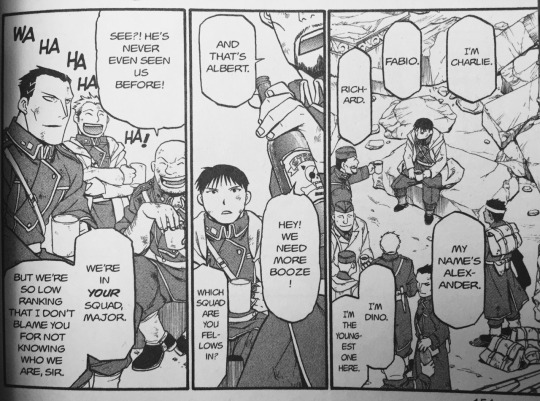
Roy feels guilty for not even knowing the men who were underneath him. He reflects on the fact that he can barely remember the names of his comrades who died, and doesn’t know a thing about the Ishvalans he killed. The surviving squad members thank him for ending the war and hail him as a hero, which leads Roy to further self-hatred and he states his vow to protect as many people as possible since he doesn’t believe that he should be hailed as a hero at all.
14. Children as victims of the war
Brotherhood seems to shy away from the fact that a lot of the Ishvalans who were killed were children. Throughout the anime we’re occasionally shown children running or crying, but never outright see children injured or dead (at least, not up close or in a graphic way).
On the other hand Arakawa is not only unafraid to show children as the victims, but actually emphasises how many children were killed.
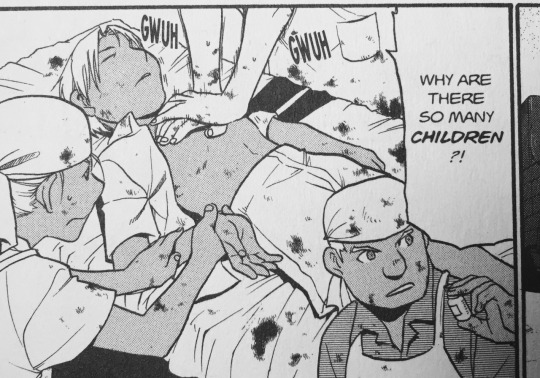
We see the Rockbells struggling to cope, and Sara becoming desperate as she tries to save a child. We’re shown Ed, Al, and Winry sitting at home to really put forward the fact that children of their age are the ones getting killed in the war.
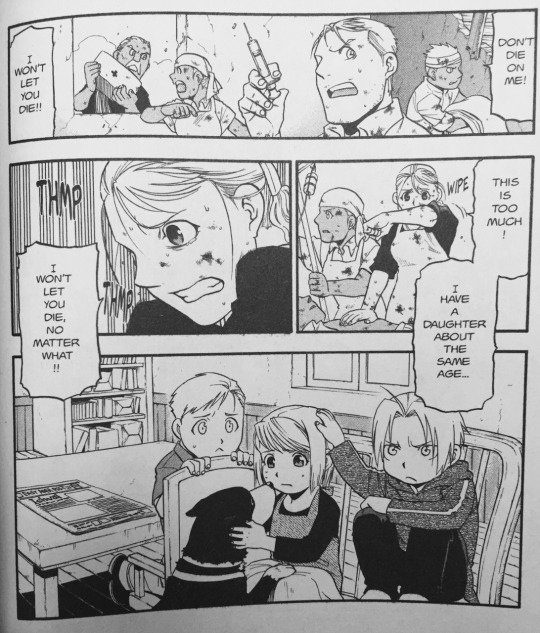
15. The overall portrayal of the war, and how Volume 15 was written/illustrated
The main difference that I see between the manga’s portrayal of Ishval and Brotherhood’s adaptation is that the manga really made it feel like a war. Brotherhood has some bloody scenes, but nowhere near to the extent that the manga shows.
At the start of volume 15, there’s a brief note from Arakawa about the writing of these chapters. She states that she interviewed WWII war veterans, read books, and watched films and footage at length to make sure she portrayed war as realistically as possible. Her research really shows throughout the volume. In most scenes, even if it’s a scene of two characters having a conversation, dead bodies, rubble, and blood are commonly visible in the background. This increases more and more as the chapters go on, showing the destruction pile up as the Ishvalans are wiped out.

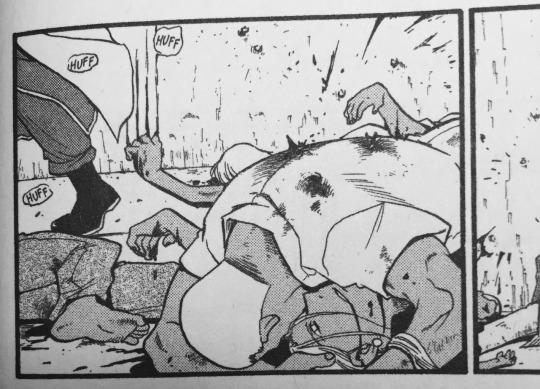
As well as bodies, we also see people being killed very violently. We see victims of Roy’s flame alchemy charred, crying, and struggling to breathe as he finishes them off at close range, something which Brotherhood never showed.
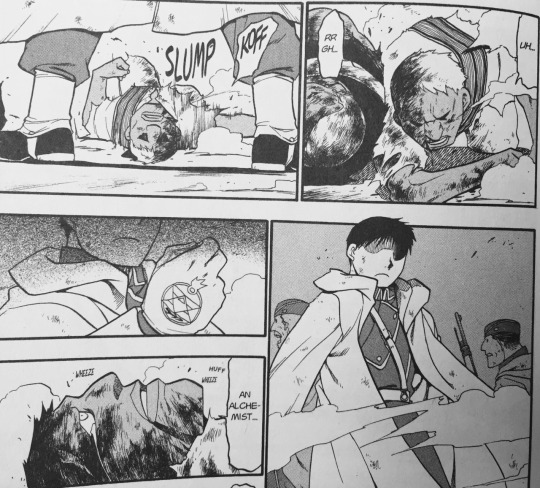

There’s an incredible inverted colour two-page spread which showcases all aspects of the war together. There are panels of the state alchemists carrying out their work, panels of explosions and children crying, dead bodies and charred corpses, with Envy laughing maniacally by the side. I’d post it here but I really wouldn’t do it any justice by having it shrunk down.
The final thing I wanted to say is just how much of a genius writer Arakawa is. FMA was released monthly when it was being written, and yet all four Ishval chapters fit perfectly in one volume and flow into one another with this incredible atmosphere which builds up right to the end of the war. It’s an atmosphere that I can’t really put into words, but it’s something which leaves me with a feeling of sadness, unease and satisfaction all at once every time I read the entire volume from start to finish. I refuse to believe that Arakawa didn’t plan this ahead to make sure all four chapters ended up as one volume.
To conclude I want to reiterate my plea: please buy volume 15 of the FMA manga and read it if you haven’t done so already. The many excerpts which I included in this long post are only a fraction of what these four chapters have to offer. Brotherhood’s depiction of Ishval doesn’t even come close to matching up with Arakawa’s incredible, thoroughly-researched portrayal of war, and reading this part of the manga will help any anime-only fans to appreciate the series even more.
Thanks for reading!
#fullmetal alchemist#fma#fma manga#fullmetal alchemist brotherhood#fmanalysis#this is super long but i've wanted to talk about it in depth for years now
4K notes
·
View notes